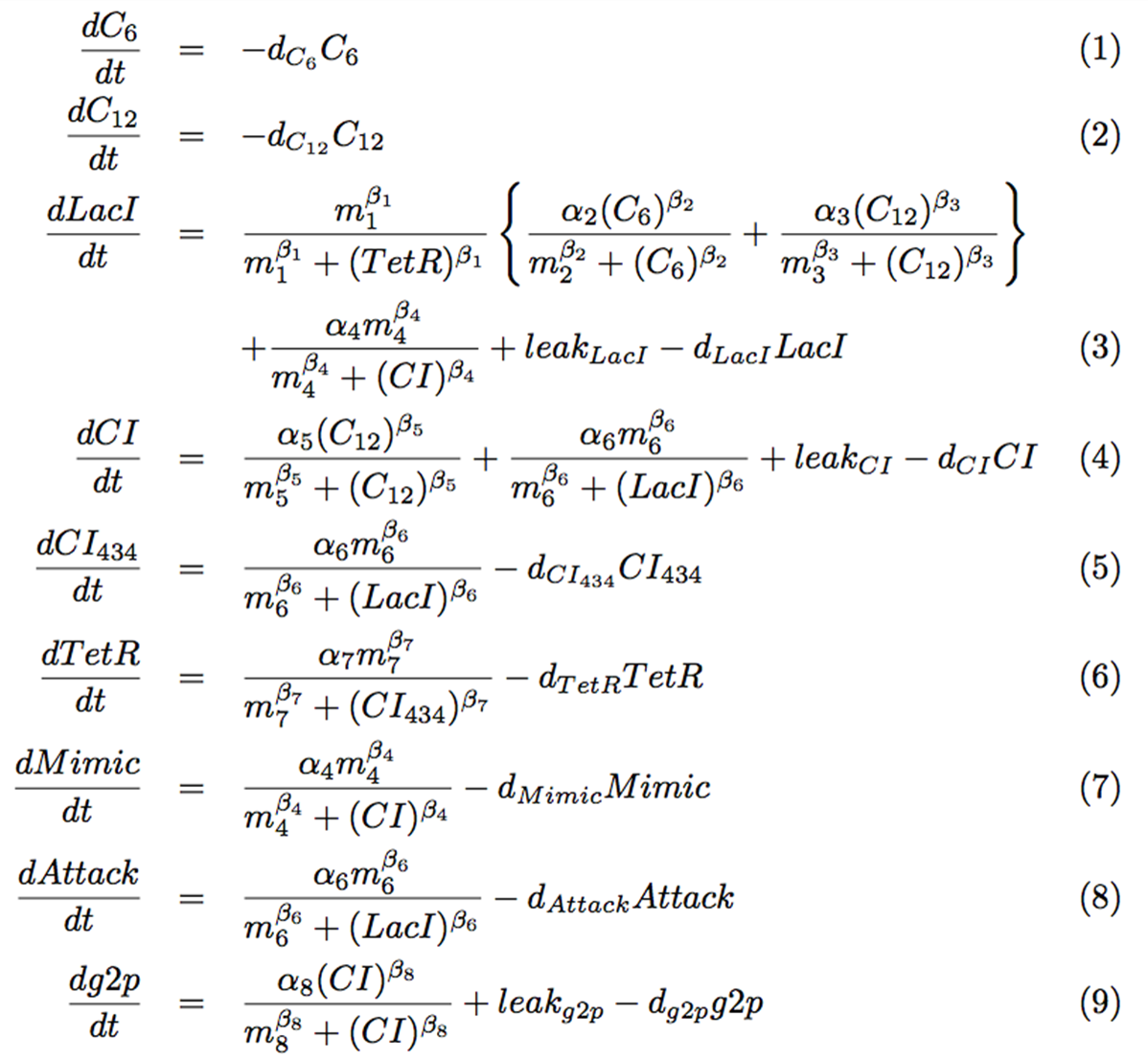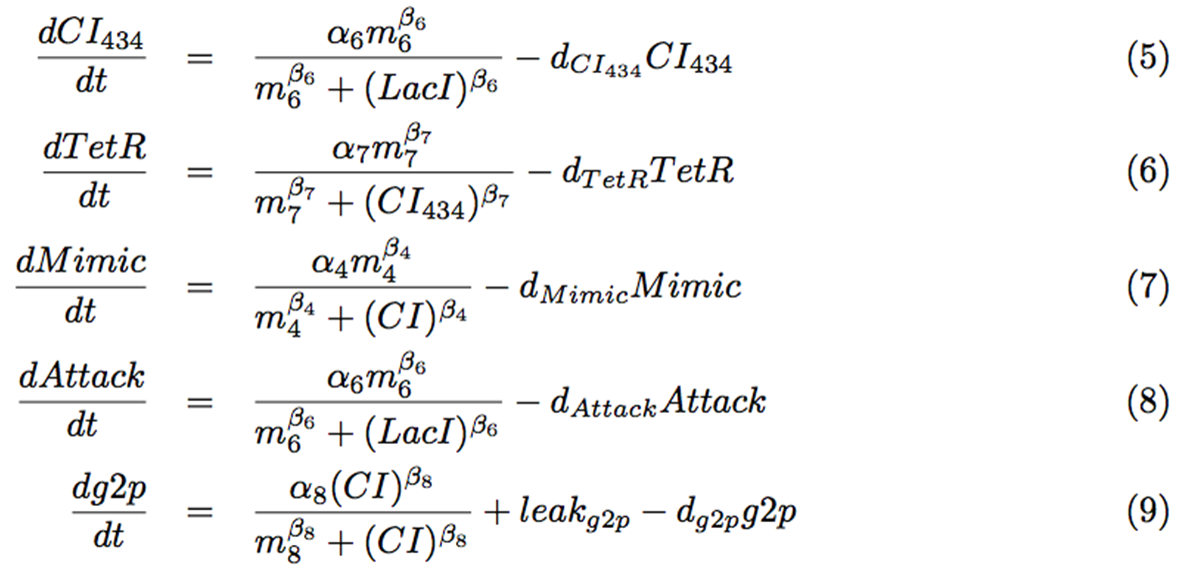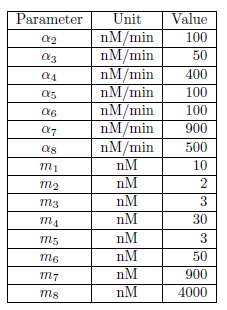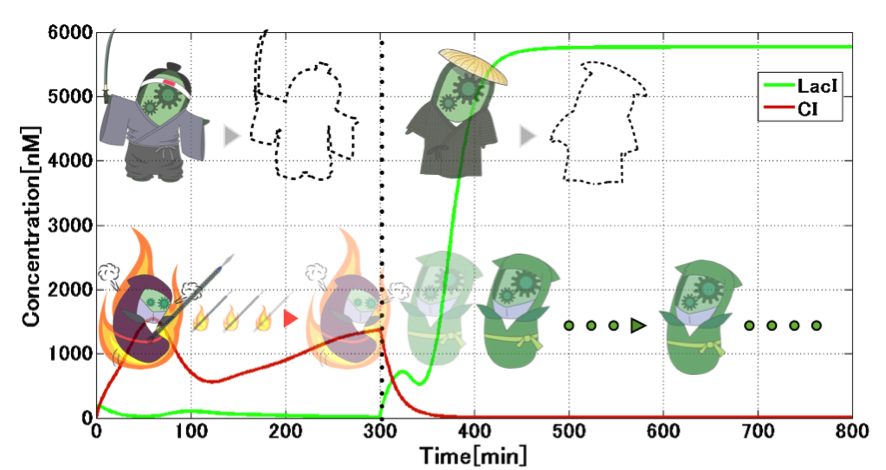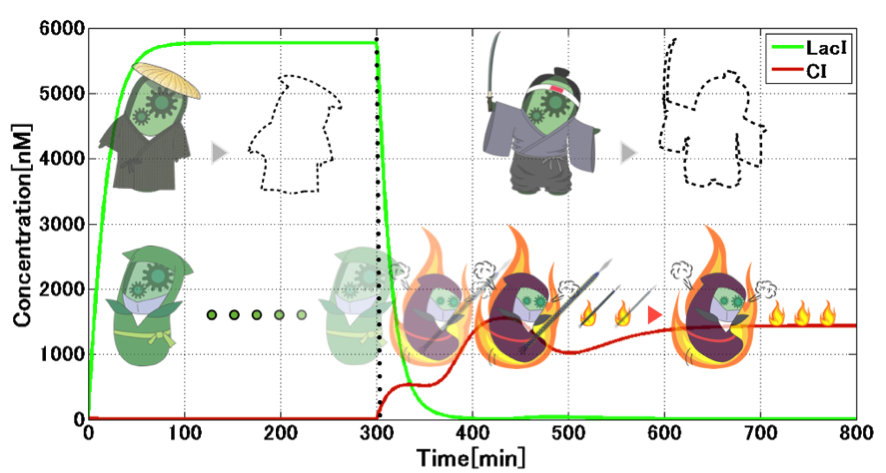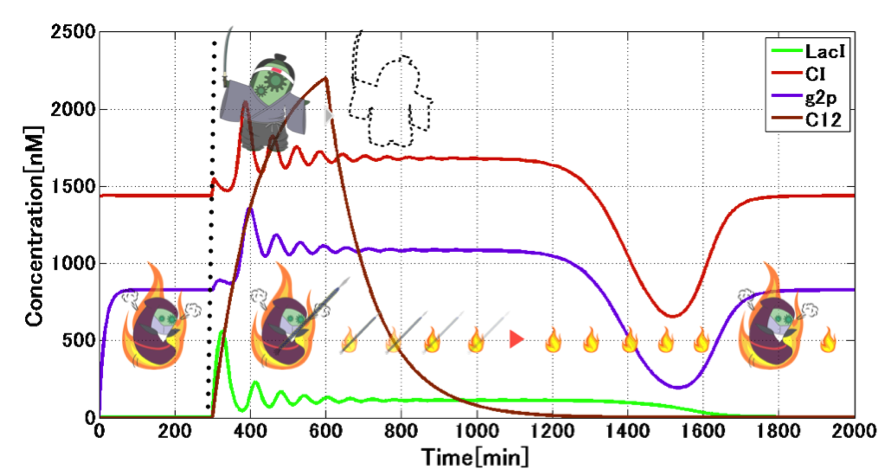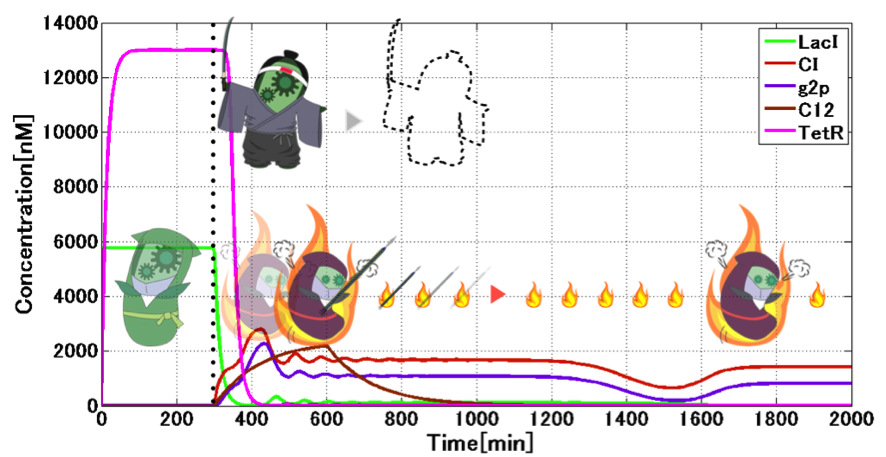Team:Tokyo Tech/Modeling/Crosstalk Circumvention
From 2013.igem.org
Modeling of Ninja circuit
1.Introduction
In order to achieve Signal-dependent state change circuit with crosstalk circumvention, we designed ‘’Ninja circuit’’ which is shown in Fig. 1-1.
We analyzed the dynamic characteristics of the whole circuit by modeling Ninja circuit through the modeling of “Ninja” circuit. In addition, we verified how each parameter in the model formula affects the behavior of the circuit.
To understand the difference between the original circuit, which cannot prevent from signal crosstalk, and our Ninja model, we compared with two gene circuits on equal terms.
2.Analytical method of dynamic characteristics of the circuit
2.1 Mathematical model construction
On the basis of the Hill equation, we built a mathematical model of the Ninja circuit. The mathematical model which was used this time was as below. Value for each parameter will be discussed on Chapter 2.3 .
At this time, because of the constant expression of Las and LuxI, we can assume that there are C6 and C12 as input into consideration.
Fig2.1.1 is differential equations that describe the changes of C6 and C12. In the circuit we made this time, only degradation of C6 and C12 are considered because they are inputs from the outside.
Fig.2.1.2 is differential equations of LacI. Since we use Promoter TetR that acts as a repressor, the first term shows the suppression of TetR. Although hybrid promoters which express LacI are activated by C6, we have to consider the influence of the crosstalk, which is represented as addition.
We set a3 as half of a2, because C12 which act as crosstalk is about half of the total,. LacI is not only a hybrid promoter; it is also expressed as one side of the toggle switch. We add a Hill equation to suppress CI. In the end we add expression amount of the leak, then minus the decomposition item of LacI.
CI is as same as LacI, which is expressed as one side of the toggle switch. This equation consists of the activation of C12, the repression of LacI, leaky expression and degradation.
The rest equation of proteins is shown in Fig.2.1.5.
2.2 Description of the parameters
Each parameter is defined as the following table.
2.3 Values of the parameters and simulation
We carried out the simulation of this time by using MatLab. Since the amount of the parameters of the differential equation is very large, we tried to minimize the amount of the evaluation function. (Fig.2.2.1)
At first we add C12, 300min after induction of the GFP side in toggle switch, C12 is added before the simulation starts. If the absolute value of the difference between the integral value of the expression level of RFP and GFP becomes smaller, we could get the conclusion that toggle switch has high performance. a5 and a6 are two corrections in the maximum expression amount. The graph represents the absolute value of the difference of the area of the red line on the RFP and the green line of GFP. The parameters we are about to explore are a4, a5, which are maximum expression amounts of LacI and CI in bistable state, and a6, a7, which are expression amounts of CI434 and TetR as in prevention of crosstalk.
2.4 Simulation result and parametric evaluation
As a result of exploring the a4, a5, a6, a7 to minimize the evaluation function in 2.3, we found out that it would be the best selection if we take the parameters as follows. (Fig.2.3.2)
The following graph has been obtained by using the above parameters. In initial state, by the addition of 20nm C12, the CI side get induced、after 300min, with the addition of 20nm C6, the toggle switch starts to switch. We could get the conclusion that the toggle stays stable after the switching.
Then, we will confirm the performance of the other side of the toggle switch. First, 20nm C6 was added, then after 300min C12 was added. (Fig.2.4.3) we could got the conclusion that the toggle switch could work as we thought.
After the toggle is confirmed, we analyzed the switching performance between Ninja’s cautious state and shuriken state. When switching occurs from cautious state to shuriken state, CI is expressed abundantly by the influence of C12 expressed from E.Samurai. As C12 decomposes, shuriken state should switch back to cautious state.
Fig.2.4.4 shows the g2p expression when it switches from cautious state to shuriken state by the addition of C12. First it stays cautious state, after 300mins, C12 is expressed from E.Samurai. Only when C12 is being produced, g2p expresses. And when C12 decomposes, it will go back to the LacI state.
Then, Fig.2.4.5 shows that when E.Samurai comes, civilian state will switch to shuriken state. We can know from the graph that when E.Samurai comes at 300min, civilian state will switch to shuriken state which expresses g2p.
When LacI state switches to shuriken state, CI will converge with vibration. This is because not only the toggle switch, but also there are TetR, LacI and CI434 which suppress with each other and vibrates in the circuit. As adding C12 from outside, TetR vibrates and decays, according to the effect, CI will vibrate and be settled down to a constant value. Moreover, the amount of CI decides the expression level of g2p, so we can know g2p will vibrate, too. The following graph shows the vibration and attenuation of TetR.
In the end, we consider the situation that when E.Civilian comes. Fig.2.4.7 shows the switching from cautious state to civilian state which is influenced by C6 came from E.Civilian. We can know from this simulation result that when E.Civilian comes on the time of 300min, CI cautious state will switch to civilian state.
We discuss the effect of CI434 which is for switching from cautious state to civilian state. When changing happens, if there is no CI434, TetR will affect the promoter C6 directly. So before the switching starts, the promoter LacI will be suppressed. CI434 plays an important role in keeping the time until it switches normally. Fig.2.4.8 includes TetR.
3.Analytical method of effectiveness of crosstalk prevention circuit
3.1 Model without crosstalk prevention circuit
Since we already have the simulation result of “Ninja” model, to verify the difference of the original toggle circuit which cannot prevent from the crosstalk of signal and “Ninja” circuit, we have to establish the original model. It was defined as follows.
Value of the parameter used here is the same as the value used in Fig.2.4.1
3.2 Simulation results
We compare with two circuits about the characteristics of changing from LacI state to CI state. The reason why we won’t compare them in the opposite way (changing from CI state to LacI state) is that crosstalk won’t occur in both directions. We analyzed the case which the initial state is with enough LacI, then it change to the state with enough CI at 300min by the increase of C12 expressed from E.Samurai. The following graph shows the changing of LacI and CI. The solid line presents the case with crosstalk prevention circuit, and the dotted line stands for the case without crosstalk prevention circuit. When there is certain amount of C12 production, LacI is produced in a certain amount in the toggle without crosstalk prevention circuit, and in contrary, the crosstalk would not be conspicuous. But in “Ninja” circuit which there is crosstalk prevention circuit, LacI would not be produced and switching to the CI state is conspicuous.
When E.samurai has gone at 1500min, the concentration of LacI expressed by “Ninja” circuit is about 25nM. In contrast, the concentration of LacI expressed by the original circuit, which cannot prevent from the crosstalk, is 725nM. Regarding the convergence of LacI, we can conclude that LacI expressed by “Ninja” circuit will be converged faster than the original circuit does.
 "
"



